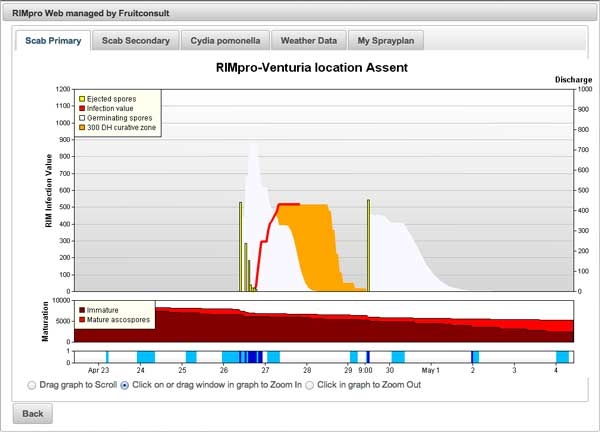(continued from last month) At what stage do fungicides work
Contact fungicides like captan and sulphur kill spores during the germination process.
These are the spores in the white cloud in the graph, which is called the germination window.
Contact fungicides can be put on before the rain, but only the residue still present after the rain during the germination window is active.
A contact fungicide applied during the germination window is the most effective treatment to stop an infection. Only then do you hit the moment of action of these fungicides and bring the full dose of your application to work.
Dodine and lime sulfur are both effective during the germination window, and have limited curative efficacy till about 300 DH (Degree Hours) after start of infection.
The mode of action of potassium bicarbonate however, is only curative and it is easily washed off by rain. That narrows the window of application for potassium bicarbonate down to the first 300 DH after the infection.
Systemic fungicides have no effect on germination but can stop the development of the fungus in the leaf up till 1000 DH post infection.
Resistance: game over!
Most commercial important apple varieties are highly susceptible to scab.
Organic fruit growers in Europe moved to modern Vf scab resistant varieties to realize low input production, and ease their life. Unfortunately scab races breaking the Vf resistance have developed in most European production areas, leaving the Vf varieties as susceptible as the standard apple varieties.
As it is now, all commercial important apple varieties have to be regarded as susceptible and should be protected well.
In spring there is no room for thresholds as failures lead to extra treatments in summer compromising the goal of environmentally friendly and residue-low production.
Another unfortunate fact is that the scab fungus develops resistance against fungicides. All over Europe, scab populations have developed that are less susceptible to all groups of systemic fungicides.
The practical consequence is that scab management should be based on the accurate application of contact fungicides.
When the number of applications of these contact fungicides is limited by label restrictions, it is obvious that effective scab management becomes precision work.
The power of numbers
We don’t like it, but there is a lot of chance involved in scab control.
Continued next month
For more information, see Tree Fruit August 2014




















